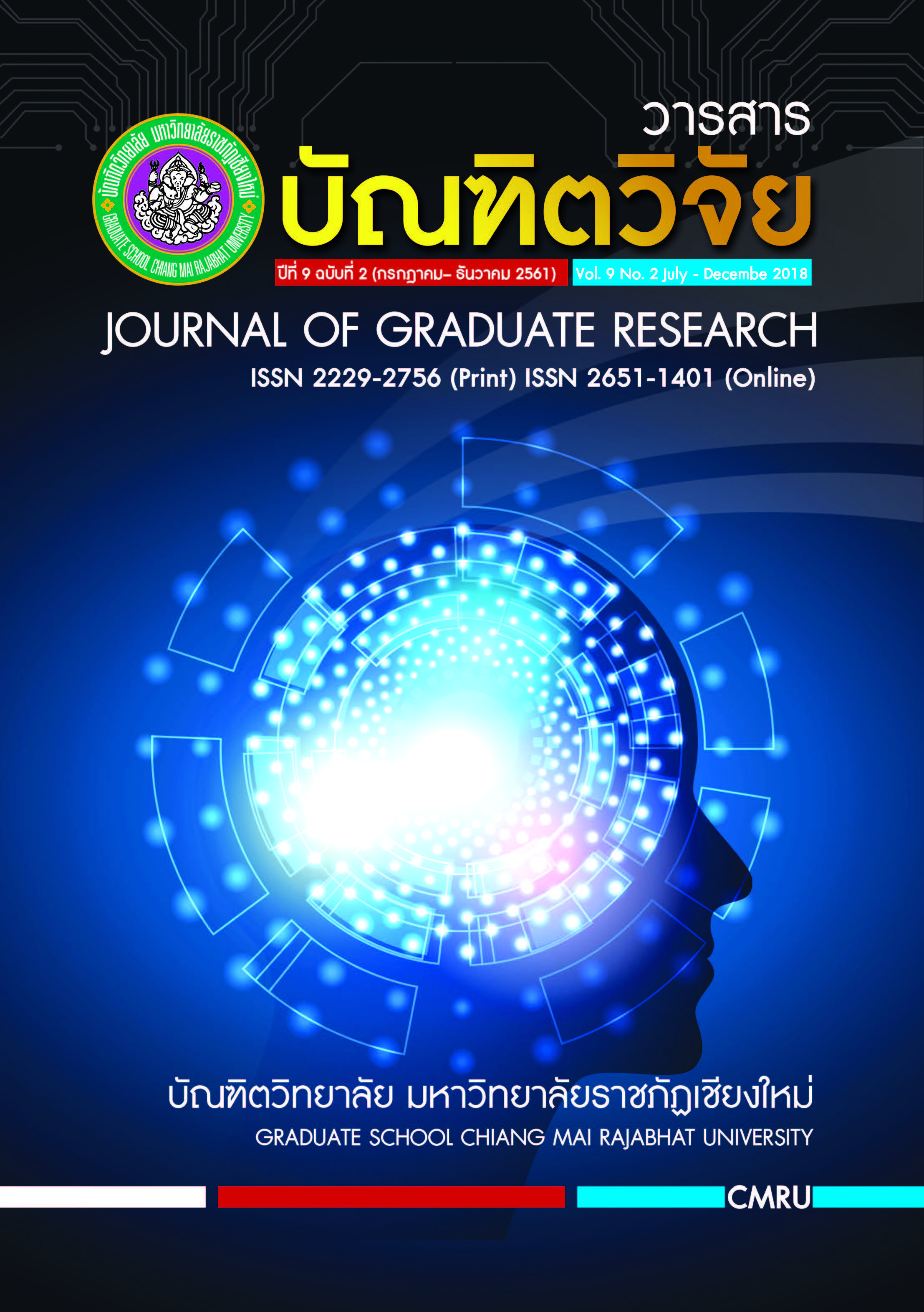Effects of BBL Playground on Physical Fitness and Physical Intelligence Quotient in Elementary Students
Main Article Content
Abstract
This study aimed to investigate and compare the effects of playing in a BBL playground on the physical fitness and Physical Intelligence Quotient of elementary school students. The subjects were 30 elementary school students between the ages of 7 and 8 years. BBL playground was used as a teaching method for students 5 days a week, with each session lasting 60 minutes, for the duration of 8 weeks. The IOC scores of the constructed playing program were higher than 0.5 in every item. The physical fitness which was related to students’ health and the Physical Intelligence Quotient (PQ) test was used before and after the experiment by t-test.
The results showed that after using the playing program in BBL playground, the physical fitness of the male students including sit-ups (60 seconds), push-ups (30 seconds), sit and reach, and zig-zag run was improved (p<.05). In the female students, the Body Mass Index including, sit-ups (60 seconds), push-ups (30 seconds) and zig-zag runs was improved (p<.05). In terms of Physical Intelligence Quotient measured by the Physical Intelligence Quotient test, it was found that the average time of putting coins in cans and obstacle racing after the experiment were improved (p<.05).
In conclusion, playing in a BBL playground can improve the students’ physical fitness. It also helped improve students’ Physical Intelligence Quotient in terms of fundamental movement skills and general motor skills involving cognitive response and body control in following orders of the elementary school students.
Article Details
References
ชวภรณ์ สุริยจันทร์. (2554). ผลการใช้โปรแกรมสร้างเสริมสมรรถภาพทางกายแบบสถานีสำหรับนักเรียนระดับปฐมวัย. (วิทยานิพนธ์ศึกษาศาสตรมหาบัณฑิต, มหาวิทยาลัยเชียงใหม่).
ชิตินทรีย์ บุญมา. (2552). รูปแบบการเรียนการสอนพลศึกษาโดยใช้หลักการเรียนรู้ของสมองเป็นฐาน เพื่อพัฒนาการเรียนรู้และสมรรถภาพทางกายที่สัมพันธ์กับทักษะสำหรับนักเรียนระดับชั้น ประถมศึกษาปีที่ 1. (วิทยานิพนธ์ครุศาสตดุษฎีบัณฑิต, สาขาวิชาพลศึกษา จุฬาลงกรณ์มหาวิทยาลัย).
ชัชชัย โกมารทัต. (2550). แนวทางการส่งเสริมและสนับสนุนกีฬาพื้นเมืองไทยในการพัฒนาพื้นฐาน นักกีฬาไทย. กรุงเทพฯ: คณะวิทยาศาสตร์การกีฬา จุฬาลงกรณ์มหาวิทยาลัย.
ปริญญา ปทุมมณ. (2554). ผลของโปรแกรมการฝึกร่างกายโดยใช้การเล่นพื้นเมืองไทยที่มีต่อความฉลาดทางสติปัญญา ความฉลาดทางอารมณ์และความฉลาดทางการเคลื่อนไหวร่างกาย ในเด็กชั้นประถมศึกษาชาย อายุ 10 – 12 ปี. (วิทยานิพนธ์วิทยาศาสตรมหาบัณฑิต, สาขาวิชาวิทยาศาสตร์การกีฬา จุฬาลงกรณ์มหาวิทยาลัย).
วรศักดิ์ เพียรชอบ. (2548). หลักการพลศึกษา. กรุงเทพฯ: กรมวิชาการ กระทรวงศึกษาธิการ.
สำนักงานคณะกรรมการสุขภาพแห่งชาติ. (2560). การประชุมสมัชชาสุขภาพแห่งชาติ ครั้งที่ 10,10 ปี พ.ร.บ. สุขภาพแห่งชาติ สู่สังคม
สุขภาวะ. 20-22 ธันวาคม 2560 ณ อิมแพ็ค ฟอรั่ม เมืองทองธานี. กรุงเทพฯ: เอกสารสมัชชาสุขภาพ. สืบค้นจาก https://www.samatcha.org/node/178
สุพิตร สมาหิโต. (2549). แบบทดสอบและเกณฑ์มาตรฐานสมรรถภาพทางกายที่สัมพันธ์กับสุขภาพ สำหรับเด็กไทย อายุ 7-18 ปี. กรุงเทพฯ: สำนักงานกองทุนสนับสนุนการสร้างเสริมสุขภาพ (สสส.).
สุพิตร สมาหิโต.(2551). เอกสารประกอบการอบรมวิชาพลศึกษาโครงการอบรมการออกแบบกระบวนการเรียนรู้ ตามหลักสูตรการเรียนรู้แบบ BBL .กรุงเทพฯ: สถาบันส่งเสริมอัจฉริยภาพและนวัตกรรมการเรียนรู้.
สมบูรณ์ อินทร์ถมยา. (2547). การพัฒนาเครื่องมือวัดปัญญาด้านการรับรู้ภาวะการเคลื่อนไหวของร่างกาย. (วิทยานิพนธ์ครุศาสตรดุษฎีบัณฑิต, สาขาวิชาพลศึกษา คณะครุศาสตร์ จุฬาลงกรณ์มหาวิทยาลัย).
สำนักงานคณะกรรมการการศึกษาขั้นพื้นฐาน. (2551). คู่มือหลักสูตรแกนกลางการศึกษาขั้นพื้นฐาน 2551. กรุงเทพฯ: โรงพิมพ์ชุมนุมสหกรณ์การเกษตรแห่งประเทศไทย.
อัครภูมิ จารุภากร และพรพิไล เลิศวิชา. (2550). สมอง เรียน รู้. กรุงเทพฯ: สถาบันวิทยาการการเรียนรู้.
อัจฉรียา กสิยะพัท. (2558). การส่งเสริมกิจกรรมทางกายในวัยเด็กอายุ 9-11 ปี. กรุงเทพฯ: ศูนย์วิจัยกิจกรรมทางกายเพื่อสุขภาพ สำนักงานกองทุนสนับสนุนการสร้างเสริมสุขภาพ (สสส.).
Brunoni, A. R., Lopes, M., & Fregni, F. (2008). A systematic review and meta-analysis of clinical studies on major depression and BDNF levels: implications for the role of neuroplasticity in depression. International Journal of Neuropsychopharmacology, 11(8), 1169-1180.
Colcombe, S. J., Erickson, K. I., Scalf, P. E., Kim, J. S., Prakash, R., McAuley, E., ... & Kramer, A. F. (2006). Aerobic exercise training increases brain volume in aging humans. The Journals of Gerontology Series A: Biological Sciences and Medical Sciences, 61(11), 1166-1170.
Chaddock, L., Pontifex, M. B., Hillman, C. H., & Kramer, A. F. (2011). A review of the relation of aerobic fitness and physical activity to brain structure and function in children. Journal of the International Neuropsychological Society, 17(6), 975-985.
Gardner, H. (1983). Frames of Mind: The Theory of Multiple Intelligences. New York: Basic Books.
Jensen, E. (2000). Brain-Based Learning. San Diego: Brain Store Incorporated
Kramer, A. F., Hahn, S., Cohen, N. J., Banich, M. T., McAuley, E., Harrison, C. R., ... & Colcombe, A. (1999). Ageing, fitness and neurocognitive function. Nature, 400(6743), 418.
Mandolesi, L., Polverino, A., Montuori, S., Foti, F., Ferraioli, G., Sorrentino, P., & Sorrentino, G. (2018). Effects of Physical Exercise on Cognitive Functioning and Wellbeing: Biological and Psychological Benefits. Frontiers in psychology, 9(509), 1-11.
Regate, C and Geoffrey, C. (1990). A Brain-Based Process for Restructuring Schools and Renewing Education. (2nd Ed). Tucson, AZ: Zephyr Press
Voss, M. W., Chaddock, L., Kim, J. S., VanPatter, M., Pontifex, M. B., Raine, L. B., ... & Kramer, A. F. (2011). Aerobic fitness is associated with greater efficiency of the network underlying cognitive control in preadolescent children. Neuroscience, 199, 166-176.

